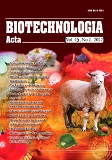ISSN 2410-7751 (Друкована версія)
ISSN2410-776X (Електронна версія)

Biotechnologia Acta Т. 15, No. 2, 2022
P. 60-61, Bibliography 4, Engl.
UDC: 577.29
https://doi.org/10.15407/biotech15.02.060
LIMITED PROTEOLYSIS OF FIBRINOGEN αC-REGION REVEALS ITS STRUCTURE
Y. Kucheriavyi, O. Hrabovskyi, A.V. Rebriev, Y. Stohnii
Palladin Institute of Biochemistry of the National Academy of Sciences of Ukraine, Kyiv
Aim. The purpose of our study was to compare hydrolytic action of proteases from Gloydius halys halys, Agkistrodon contortrix contortrix and Calloselasma rhodostoma rhodostoma snake venoms and from Bacillus thuringiensis вар. israelensis IMV B-7465 culture medium on αC-regions of fibrinogen molecule.
Methods. Products of hydrolysis were characterized by SDS-PAGE under reducing conditions with following Western-Blot using the mouse monoclonal 1-5А (anti-Aα509-610) and ІІ-5С (anti-Aα20-78) antibody. MALDI-TOF analysis of fibrinogen hydrolysis products was performed using a Voyager-DE.
Results. Combination of SDS-PAGE, FPLC and MALDI-TOF analysis enabled to detect the peptide bonds cleaved by studied proteases. In particular proteases from Gloydius halys halys and Agkistrodon contortrix contortrix snake venoms cleaved peptide bond Aα413-414. Action of protease from Calloselasma rhodostoma rhodostoma on fibrinogen led to the formation of hydrolytic product generated from C-terminal portion of Aα-chain that corresponded to fragments generated by enzymes from two other snakes. On the other hand protease from Bacillus thuringiensis вар. israelensis IMV B-7465 culture medium cleaved peptide bond Aα504-505.
Conclusions. Use of limited proteolysis technique as the source of additional information for computer modeling allowed us to propose an improved model of 3D-structure of fibrinogen αC-regions. This model takes into account the behavior of αC-regions in the physiological condition and contributes to the general knowledge about fibrinogen structure.
Key words: αC-region, fibrinogen, C-terminal, proteases.
© Palladin Institute of Biochemistry of the National Academy of Sciences of Ukraine, 2022
References
1. Medved L, Weisel J. W. Fibrinogen and Factor XIII Subcommittee of Scientific Standardization Committee of International Society on Thrombosis and Haemostasis. Recommendations for nomenclature on fibrinogen and fibrin. 2009 7(2):355?9. Epub 2008 Nov 25. PMID: 19036059; PMCID: PMC3307547. https://doi.org/10.1111/j.1538-7836.2008.03242.x
2. Chernyshenko V. O., Volynets G. P. Predicting of fibrinogen В?N-domain conformation by computer modeling and limited proteolysis. Ukr. Bioorg. Acta. 2011, 1, 53?57. https://doi.org/10.15407/ubj92.03.022
3. Chernyshenko V. O. Limited Proteolysis of Fibrinogen by Fibrinogenase from Echis multisquamatis Venom. The Protein Journal. 2015, 34(2), 103?104. https://doi.org/10.1007/s10930-015-9605-2
4. Кucheriavyi Ye. P., Gryshchuk V. I., Rebriev A. V., Platonov O. M., Savchenko K. S. The mechanism of anticoagulant action of the venom of Brachypelma smithi. Modern aspects of biochemistry and biotechnology. 2021. Kyiv. 20?21 May 2021 р. P. 29. ISBN 978-617-7026-69-2

